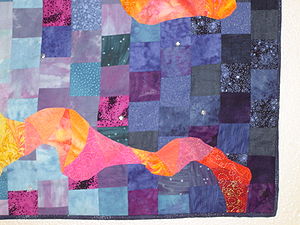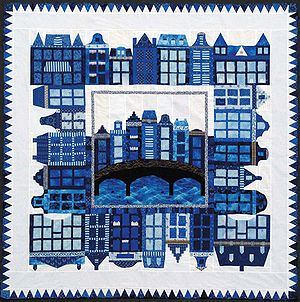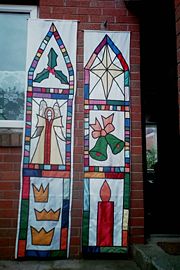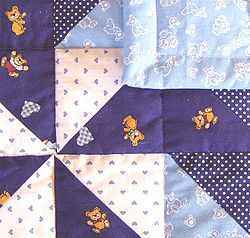
Patchwork
Encyclopedia

Needlework
Needlework is a broad term for the handicrafts of decorative sewing and textile arts. Anything that uses a needle for construction can be called needlework...
that involves sewing together pieces of fabric into a larger design. The larger design is usually based on repeat patterns built up with different colored shapes. These shapes are carefully measured and cut, straight-sided, basic geometric shapes making them easy to piece together. Precise joining makes for patchwork that lies flat without puckers.
Uses
Patchwork is most often used to make quilts, but it can also be used to make bags, wall-hangings, warm jacketJacket
A jacket is a hip- or waist-length garment for the upper body. A jacket typically has sleeves, and fastens in the front. A jacket is generally lighter, tighter-fitting, and less insulating than a coat, which is outerwear...
s, skirt
Skirt
A skirt is a tube- or cone-shaped garment that hangs from the waist and covers all or part of the legs.In the western world, skirts are usually considered women's clothing. However, there are exceptions...
s , waistcoats and other items of clothing
Clothing
Clothing refers to any covering for the human body that is worn. The wearing of clothing is exclusively a human characteristic and is a feature of nearly all human societies...
. Some textile artists work with patchwork, often combining it with embroidery
Embroidery
Embroidery is the art or handicraft of decorating fabric or other materials with needle and thread or yarn. Embroidery may also incorporate other materials such as metal strips, pearls, beads, quills, and sequins....
and other forms of stitchery.
When used to make a quilt
Quilt
A quilt is a type of bed cover, traditionally composed of three layers of fiber: a woven cloth top, a layer of batting or wadding and a woven back, combined using the technique of quilting. “Quilting” refers to the technique of joining at least two fabric layers by stitches or ties...
, this larger patchwork or pieced design becomes the "top" of a three layered quilt, the middle layer being the batting, and the bottom layer the backing. To keep the batting from shifting a patchwork or pieced quilt is often quilted
Quilting
Quilting is a sewing method done to join two or more layers of material together to make a thicker padded material. A quilter is the name given to someone who works at quilting. Quilting can be done by hand, by sewing machine, or by a specialist longarm quilting system.The process of quilting uses...
by hand or machine
Sewing machine
A sewing machine is a textile machine used to stitch fabric, cards and other material together with thread. Sewing machines were invented during the first Industrial Revolution to decrease the amount of manual sewing work performed in clothing companies...
using a running stitch which can outline the individual shapes that make up the pieced top, or the quilting stitches can be random or highly ordered overall patterns that contrast with the patchwork composition.


History
Evidence of patchwork—piecing small pieces of fabric together to create a larger piece, then quilting layers of textile together—has been found throughout history. The earliest examples have been located in Egyptian tombs and also in early age of China about 5000 years ago. Further finds have been dated from the early Middle AgesMiddle Ages
The Middle Ages is a periodization of European history from the 5th century to the 15th century. The Middle Ages follows the fall of the Western Roman Empire in 476 and precedes the Early Modern Era. It is the middle period of a three-period division of Western history: Classic, Medieval and Modern...
, where layers of quilted fabric were used in the construction of armour—this kept the soldiers warm and protected. Japanese armour was made in a similar fashion.
Using this technique, quilts began to appear in households of the 11th to 13th centuries. As the European climate became colder around this time, the incidence of the use bed quilts rose, and so developed the practice of embellishing a simple cloth through the creation of pattern and design, alongside the development of decorative quilting. The tradition of making quilts in this fashion was taken to America by the Pilgrims.
In America
Patchwork enjoyed a widespread revival during the Great DepressionGreat Depression
The Great Depression was a severe worldwide economic depression in the decade preceding World War II. The timing of the Great Depression varied across nations, but in most countries it started in about 1929 and lasted until the late 1930s or early 1940s...
because it was a way to recycle worn clothing into warm quilts. Even very small and worn pieces of material are suitable for use in patchwork, although crafters today more often use specially bought 100% cotton
Cotton
Cotton is a soft, fluffy staple fiber that grows in a boll, or protective capsule, around the seeds of cotton plants of the genus Gossypium. The fiber is almost pure cellulose. The botanical purpose of cotton fiber is to aid in seed dispersal....
patchwork material as the basis for their designs.
In the US, patchwork declined after World War II
World War II
World War II, or the Second World War , was a global conflict lasting from 1939 to 1945, involving most of the world's nations—including all of the great powers—eventually forming two opposing military alliances: the Allies and the Axis...
, but was again revived during the American
United States
The United States of America is a federal constitutional republic comprising fifty states and a federal district...
bicentennial.
Making
In the past, hand quilting was often done in a group around a frame. Instead of quilting, the layers are sometimes tied together at regular intervals with pieces of yarn, a practice known as tying or knotting.Structure
There are three traditional structures used to construct a patchwork or pieced composition: 1) the block, 2) overall, and 3) strip piecing. Traditional patchwork has identifying names based on the arrangement of colors and shapes.Blocks
Patchwork blocks are pieced squares made up of colored shapes that repeat specific shapes to create patternPattern
A pattern, from the French patron, is a type of theme of recurring events or objects, sometimes referred to as elements of a set of objects.These elements repeat in a predictable manner...
s within the square or block, of, say, light and dark, or contrasting colors. The blocks can all repeat the same pattern, or blocks can have several different patterns . The patchwork blocks are typically around 8–10" square (20cm to 25cm). They are sewn together in stacked rows to make a larger composition. Often strips of contrasting fabric forming a lattice separate the patchwork blocks from each other. Some common patchwork block names are Log Cabin, Drunkard's Path, Bear's Paw, Tulip, and Nine Patch. A unique form of patchwork quilt is the crazy quilt. Crazy quilting
Crazy quilting
The term "crazy quilting" is often used to refer to the textile art of crazy patchwork and is sometimes used interchangeably with that term. Crazy quilting does not actually refer to a specific kind of quilting , but a specific kind of patchwork...
was popular during the Victorian era
Victorian era
The Victorian era of British history was the period of Queen Victoria's reign from 20 June 1837 until her death on 22 January 1901. It was a long period of peace, prosperity, refined sensibilities and national self-confidence...
(mid–late 19th century). The crazy quilt is made up of random shapes of luxurious fabric such as velvet
Velvet
Velvet is a type of woven tufted fabric in which the cut threads are evenly distributed,with a short dense pile, giving it a distinctive feel.The word 'velvety' is used as an adjective to mean -"smooth like velvet".-Composition:...
s, silk
Silk
Silk is a natural protein fiber, some forms of which can be woven into textiles. The best-known type of silk is obtained from the cocoons of the larvae of the mulberry silkworm Bombyx mori reared in captivity...
s, and brocade
Brocade
Brocade is a class of richly decorative shuttle-woven fabrics, often made in colored silks and with or without gold and silver threads. The name, related to the same root as the word "broccoli," comes from Italian broccato meaning "embossed cloth," originally past participle of the verb broccare...
s. The patchwork pieces are stitched together forming "crazy" or non-repeat, asymmetric
Asymmetric
Something which is asymmetric displays asymmetry. Specific uses of the term may include:*Asymmetric relation for information on such relations in mathematics and set theory*Asymmetric warfare for information and theories of modern war...
compositions. Fancy embroidery
Embroidery
Embroidery is the art or handicraft of decorating fabric or other materials with needle and thread or yarn. Embroidery may also incorporate other materials such as metal strips, pearls, beads, quills, and sequins....
embellishes the seam lines between the individual, pieced shapes.
Overall
Overall patchwork designs are incrementally pieced geometric shapes stitched together to form a larger random or composed design. The colored shapes can be randomly pieced or follow a strict order to create a specific effect, e.g. value (light to dark) progressions, or checkerboardCheckerboard
A checkerboard or chequerboard is a board of chequered pattern on which English draughts is played. It is an 8×8 board and the 64 squares are of alternating dark and light color, often red and black....
effects. Names such as Hit or Miss, Clamshell, back-stitch, needle weave, criss-cross and Starburst identify some overall patchwork structures.
Strip piecing
Strip piecing involves stitching together pieces of fabric in repeat patterns into long strips and then stitching the strips together lengthwise. The patchwork strips can be alternated with strips of contrasting colors. A typical strip patchwork quilt is the Flying Geese pattern.Forms
Specialised forms of patchwork include:- Cathedral window
- Scrap piecework
- Foundation piecework or the closely related
- EnglishEnglandEngland is a country that is part of the United Kingdom. It shares land borders with Scotland to the north and Wales to the west; the Irish Sea is to the north west, the Celtic Sea to the south west, with the North Sea to the east and the English Channel to the south separating it from continental...
paper piecework - SeminoleSeminoleThe Seminole are a Native American people originally of Florida, who now reside primarily in that state and Oklahoma. The Seminole nation emerged in a process of ethnogenesis out of groups of Native Americans, most significantly Creeks from what is now Georgia and Alabama, who settled in Florida in...
patchwork - HawaiianHawaiian IslandsThe Hawaiian Islands are an archipelago of eight major islands, several atolls, numerous smaller islets, and undersea seamounts in the North Pacific Ocean, extending some 1,500 miles from the island of Hawaii in the south to northernmost Kure Atoll...
piecework - Stained glass windowStained glassThe term stained glass can refer to coloured glass as a material or to works produced from it. Throughout its thousand-year history, the term has been applied almost exclusively to the windows of churches and other significant buildings...
patchwork

Stained glass
The term stained glass can refer to coloured glass as a material or to works produced from it. Throughout its thousand-year history, the term has been applied almost exclusively to the windows of churches and other significant buildings...
in church windows. Satin
Satin
Satin is a weave that typically has a glossy surface and a dull back. It is a warp-dominated weaving technique that forms a minimum number of interlacings in a fabric. If a fabric is formed with a satin weave using filament fibres such as silk, nylon, or polyester, the corresponding fabric is...
fabrics simulate the colored glass, and black bias binding tape simulates the lead
Lead
Lead is a main-group element in the carbon group with the symbol Pb and atomic number 82. Lead is a soft, malleable poor metal. It is also counted as one of the heavy metals. Metallic lead has a bluish-white color after being freshly cut, but it soon tarnishes to a dull grayish color when exposed...
.
Popularity
The 2003 Quilting in America survey estimated that the total value of the American quilting industry was $2.7 billion. International quilting exhibitions attract thousands of visitors, while countless smaller exhibitions are held every weekend in local regions. Active cyber-quilting communities abound on the web; books and magazines on the subject are published in the hundreds every year; and there are many active local quilting guilds and shops in different countries. 'Quilt Art' is established as a legitimate artistic medium, with quilted works of art selling for thousands of dollars to corporate buyers and galleriesArt gallery
An art gallery or art museum is a building or space for the exhibition of art, usually visual art.Museums can be public or private, but what distinguishes a museum is the ownership of a collection...
. Quilt historians and quilt appraisers are re-evaluating the heritage of traditional quilting and antique quilts, while superb examples of antique quilts are purchased for large sums by collectors
Collecting
The hobby of collecting includes seeking, locating, acquiring, organizing, cataloging, displaying, storing, and maintaining whatever items are of interest to the individual collector. Some collectors are generalists, accumulating merchandise, or stamps from all countries of the world...
and museums. The American Quilt Study Group is active in promotion of research on the history of quilting
History of quilting
Quilting, the stitching together of layers of padding and fabric, may date back as far as ancient Egypt.-Europe:In Europe quilting appears to have been introduced by Crusaders in the 12th century , in particular in the form of the aketon or gambeson, a quilted garment worn under armour which later...
.
Trends
Today, many things are quilted using a Longarm quiltingLongarm quilting
Longarm quilting is the process by which a longarm sewing machine is used to sew together a quilt top, quilt batting and quilt backing into a finished quilt.The longarm sewing machine typically ranges from 10 to 14 feet in length...
system. The system consists of a frame and a sewing machine. The patchwork, batting and backing are loaded onto the frame and in some systems each layer can be tensioned independently. No basting is usually necessary. The frames can be up to 14' long which is big enough for a king size quilt to be tensioned ready for quilting. The sewing machine known as the Longarm machine has an extended throat space, up to 36", and it can be moved on a two-axis rail system—left and right, forwards and backwards, enabling a 360 degree movement over the surface of the quilt.
Until recently, most longarm machines were hand-guided which meant the operator had to synchronise the speed of their hands with that of the machine motor. Fast hands and slow motor meant big stitches. Slow hands and fast motor meant small stitches. Since just after the turn of the century, most longarm machines are now sold with stitch-regulation, which means that the operator no longer has to synchronize hand speed with that of the motor. Electronics in the machine ensures the stitch length remains constant. More recently, fully computerized machines are being sold. Fully computerized machines have been available for over 12 years. They were invented by Paul Statler but have only recently become popular. These machines use specialised machine-driver software and CAD-type drawing packages to enable pattern digitisation and automatic quilting. An operator is still required to mind the machine and set the pattern onto the quilt.
It is thought that over 10,000 longarm quilting machines are in use today. In the US, there are many brands available and many places to obtain training
Training
The term training refers to the acquisition of knowledge, skills, and competencies as a result of the teaching of vocational or practical skills and knowledge that relate to specific useful competencies. It forms the core of apprenticeships and provides the backbone of content at institutes of...
and few distributors and trainers in other countries where business quilters are more likely to travel to the States for ongoing longarm training.
Further reading
- Schnuppe von Gwinner (1988), The History of the Patchwork Quilt, ISBN 0-88740-136-8
- Eleanor Levie (2004), American Quiltmaking 1970–2000, ISBN 1-57432-843-3
- Celia Eddy (2005), Quilted Planet, ISBN 1-84533-009-9

